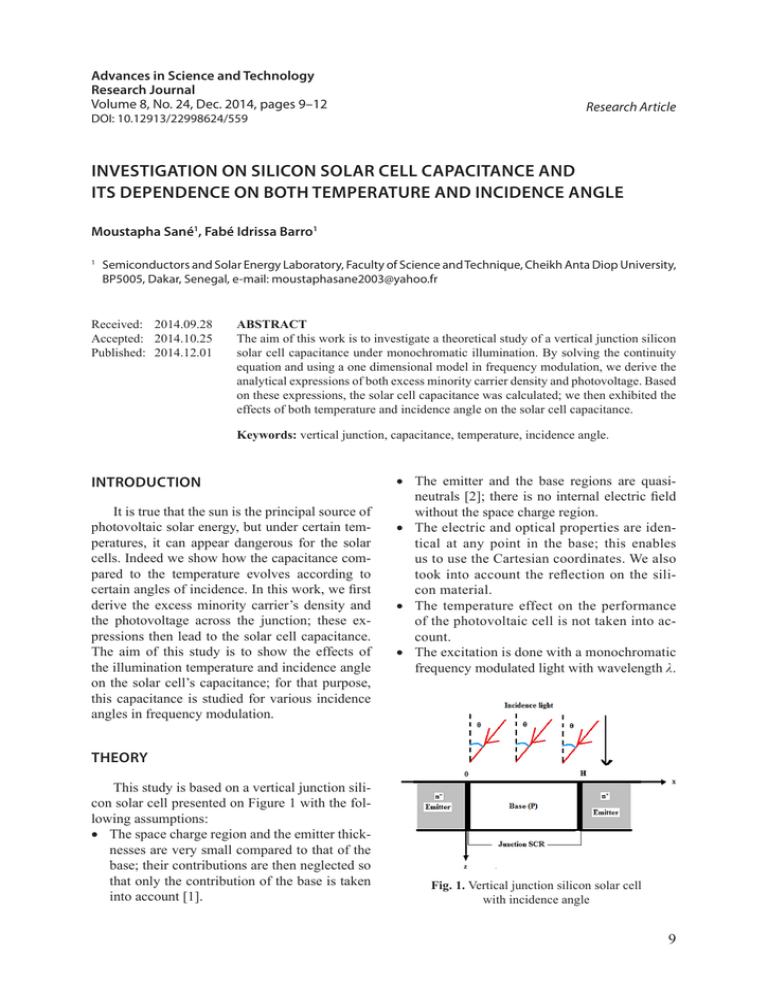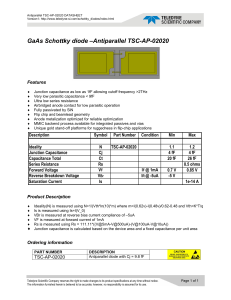
Advances in Science and Technology
Research Journal
Volume 8, No. 24, Dec. 2014, pages 9–12
DOI: 10.12913/22998624/559
Research Article
INVESTIGATION ON SILICON SOLAR CELL CAPACITANCE AND
ITS DEPENDENCE ON BOTH TEMPERATURE AND INCIDENCE ANGLE
Moustapha Sané1, Fabé Idrissa Barro1
1
Semiconductors and Solar Energy Laboratory, Faculty of Science and Technique, Cheikh Anta Diop University,
BP5005, Dakar, Senegal, e-mail: moustaphasane2003@yahoo.fr
Received: 2014.09.28
Accepted: 2014.10.25
Published: 2014.12.01
ABSTRACT
The aim of this work is to investigate a theoretical study of a vertical junction silicon
solar cell capacitance under monochromatic illumination. By solving the continuity
equation and using a one dimensional model in frequency modulation, we derive the
analytical expressions of both excess minority carrier density and photovoltage. Based
on these expressions, the solar cell capacitance was calculated; we then exhibited the
effects of both temperature and incidence angle on the solar cell capacitance.
Keywords: vertical junction, capacitance, temperature, incidence angle.
INTRODUCTION
It is true that the sun is the principal source of
photovoltaic solar energy, but under certain temperatures, it can appear dangerous for the solar
cells. Indeed we show how the capacitance compared to the temperature evolves according to
certain angles of incidence. In this work, we first
derive the excess minority carrier’s density and
the photovoltage across the junction; these expressions then lead to the solar cell capacitance.
The aim of this study is to show the effects of
the illumination temperature and incidence angle
on the solar cell’s capacitance; for that purpose,
this capacitance is studied for various incidence
angles in frequency modulation.
•• The emitter and the base regions are quasineutrals [2]; there is no internal electric field
without the space charge region.
•• The electric and optical properties are identical at any point in the base; this enables
us to use the Cartesian coordinates. We also
took into account the reflection on the silicon material.
•• The temperature effect on the performance
of the photovoltaic cell is not taken into account.
•• The excitation is done with a monochromatic
frequency modulated light with wavelength λ.
THEORY
This study is based on a vertical junction silicon solar cell presented on Figure 1 with the following assumptions:
•• The space charge region and the emitter thicknesses are very small compared to that of the
base; their contributions are then neglected so
that only the contribution of the base is taken
into account [1].
Fig. 1. Vertical junction silicon solar cell
with incidence angle
9
Advances in Science and Technology Research Journal vol. 8 (23) 2014
The incident photons flux φ(λ) is taken for AM
1.5 solar spectrum [3, 4]. This case is characteristic of the whole terrestrial applications
independently of the processing site. Indeed,
the solar radiation corresponds roughly to that
of a black body at 6000 K; while crossing
the various layers of the atmosphere, certain
wavelengths are attenuated by components of
the atmosphere such as ozone (absorption of
UV – rays in the neighborhoods of 400 nm)
or the water vapor (absorption of the infrared
wavelengths around 800 – 900 nm).
Taking into account the generation, recombination and diffusion phenomena in the base, the
equation governing the variation of the minority
carrier density δ(x, θ, z, t) under modulation frequency [5, 6] is:
∂ 2δ (x,θ , z, t ) δ (x,θ , z, t )
∂δ (x,θ , z, t )
−
= −G ( z,θ , t ) +
(1)
2
∂t
τ
∂x
where:D(ω) and τ – are respectively, the excess
minority carrier diffusion constant and
lifetime,
ω – the angular frequency,
x – the base depth along x axis,
θ – the incidence angle, z the base depth
according to the vertical axis,
δ(x, θ, z, t) – the excess minority carrier
density,
G(θ, z, t) – the carrier generation rate.
D(ω ) ⋅
The excess minority carrier density can be
written as:
δ (x, t ) = δ (x ) exp(− jωt ) (2)
The carrier generation rate is given by [7, 8]:
G (z ,θ , λ , t ) = g (z ,θ , λ ) exp(− jωt ) (3)
where the spatial part is given by:
g z, , ( )(1 R( )) ( )
(4)
exp( ( ) z ) cos( )
where: λ – the illumination wavelength,
α(λ) and R(λ) – are respectively the absorption and reflection coefficients,
t – the time and j2 = –1.
If we replace equation (2) into equation (1),
the temporary part exp(–jωt) is eliminated and we
obtain:
g ( z, θ )
∂ 2 δ ( x ) δ ( x, θ , t )
−
=−
(5)
D(ω )
L(ω ) 2
∂x 2
where: L(ω) – is the minority carrier diffusion
length.
10
The solution of this equation (5) is:
x
x
B sinh
x, , , z, A cosh
(
)
L
L( )
L( ) 2
( )(1 R( )) ( ) exp( ( ) z ) cos( )
D( )
(6)
Coefficients A and B are determined through
the following boundary conditions [4]:
•• at the junction (x = 0):
D( )
x, , , z,
Sf x, , , z, x 0
x
x 0
(7)
where: Sf – the junction recombination velocity
traducing carrier flow through the junction.
•• at the middle of the base (x = H/2):
∂δ ( x, ω , θ , z , λ )
=0 D(ω ) ⋅
(8)
∂x
x=
H
2
where: H – the base depth.
Based on the excess minority carrier density,
we can determine the photovoltage across the
junction. According to the Boltzmann’s relation,
the photovoltage is obtained by the expression [9]:
V , , z , , T
k T
q
Nb
ln 1 2 0, , , z ,
n0
(9)
where: VT – the thermal voltage,
Nb – the base doping density,
n0 – the intrinsic carrier density,
q – the elementary charge.
Based on minority carrier density and photovoltage, we can determinate the capacitance
of the solar cell. This capacitance is mainly due
to the fixed ionized charge (dark capacitance) at
the junction boundaries and the diffusion process
(diffusion capacitance) [9–12]. The solar cell’s
capacitance can be defined by:
dQ , , z,
dV , , z, , T
(10)
Q(ω ,θ , z , λ ) = qδ ( x, ω ,θ , z , λ ) x = 0
(11)
C , , z, , T
with:
Given the photovoltage expression, eq. 10
can be rewritten as:
C , , z, , T
q2
k T
ni2
0, , , z,
Nb
(12)
Advances in Science and Technology Research Journal vol. 8 (23) 2014
Under illumination, the diffusion capacitance
predominates. Based on all the previous expressions and some computation, we obtained the behavior of the solar cell capacitance presented on
the next section.
a)
RESULTS AND DISCUSSION
Based on the mathematical formulation, simulation where performed from various induced
fields through different forward biased voltages
and various external load conditions through the
dynamic junction velocity.
We present the capacitance of the solar cell
versus temperature for various incidence angles
(Figure 2).
Figure 2a shows that the capacitance of solar cell decreases in an exponential way when the
temperature increases within the interval (100K;
380K). Indeed, the increase in the temperature
causes a certain flexibility of the solar cell allowing the minority of carriers diffuse more easily.
This allows the base and the junction to empty
their carriers which will take part in the photocurrent. We can also observe a decrease of the capacitance for the chosen incidence angles; effectively, when incidence angles increases, the incident
photons flux penetrating the solar cell decreases
due to reflexion coefficient; this lead to a decrease
of excess carrier’s concentration in the base and
to an increase of the base dynamic mobility and
thus its resistivity; that why the capacitance decrease for a given operating point.
Figure 2b gives the profiles of capacitance
versus temperature reverse and show that the
slope of the straight line is 1/Vt and it intercept
the temperature axis at a value corresponding to
the activation temperature 1/To. We also see that
the more the incidence angle increases the more
the activation temperature decreases. Effectively,
the increase of incidence angle traduces the decrease of the incident photons flux so the decrease
of the sun intensity.
The figure 2c gives the profiles of capacitance
reverse versus temperature and shows that the
slope of the straight line is 1/Vt and it intercept
the capacitance axis at a value corresponding to
the dark capacitance 1/Co. We also note that the
value of the dark capacitance decreases when the
incidence angle increases. Indeed, this decrease
is due to the fall of sun intensity, thus generating
fewer carriers.
b)
c)
Fig. 2. Capacitance of silicon solar cell behavior
under temperature for various incidence angle
CONCLUSION
A theoretical study of a vertical junction of
solar cell has been presented. Based on the excess
minority carriers’ density and the photovoltage,
the solar cell capacitance has been calculated.
11
Advances in Science and Technology Research Journal vol. 8 (23) 2014
This capacitance is then studied for various incidence angle and we showed that solar cell’s
capacitance strongly depends on both incidence
angle. For the considered incidence angles range,
the capacitance decreases with increasing incidence angle.
REFERENCES
1. Sze S.M., Kwok K.N.: Physics of semiconductors
devices. Wiley, New York, NY, USA, 2007.
2. Sané M., Zoungrana M., Diallo H.L., Sahin G.,
Thiam N., Ndiaye M., Dieng M., Sissoko G.:
Influence of incidence angle on the electrical
parameters of a vertical silicon solar cell under
frequency modulation. International Journal of
Inventive Engineering and Sciences, Vol. 1(11),
2013, 37–40.
3. Sané M., Sahin G., Barro F.I., Maiga A.S.: Incidence angle and spectral effects on a vertical junction silicon solar cell capacitance. Turkish Journal
of Physics, Vol. 38, 2014, 221–227.
4. Barro F.I., Sané M., Sahin G.: Silicon solar cell
space charge region and capacitance behavior under electric field. Sylwan, Vol. 158(5), 58–66.
12
5. Sané M., Zouma B., Barro F.I.: New approach
to determine vertical parallel junction silicon solar cell parameters. Research Journal of Applied
Sciences, Engineering and Technology, Vol. 7(24),
2014, 5288–5292.
6. Mathieu H., Fanet H.: Physique des semiconducteurs et des composants électroniques. 6th Ed., Dunod, 2009.
7. Green M.A., Emery K., Hishikawa Y., Warta W.:
Progress in photovoltaics. Research and applications, Vol. 18, 2010, 144–150.
8. Green M.A.: Solar energy. Material and Solar
Cells. Vol. 92, 2008, 1305–1310.
9. Sané M.: Study of vertical junction polycristalline
silicon solar cell in frequency modulation under
monochromatic illumination with incidence angle.
Doctorate Thesis, Department of Physics, Cheikh
Anta Diop University, Dakar, Senegal, 2014.
10.Hu C.C.: Modern semiconductor devices for integrated circuits. Pearson/prentice Hall, New Jersey,
2010.
11.Boer K.W.: Introduction to space charge effects in
semiconductor. Springer-Verlag, 2010.
12.Barsoukov E., Macdonald J.R., Impedance Spectroscopy: Theory, Experiment and Applications.
Wiley: New York, 2005.


